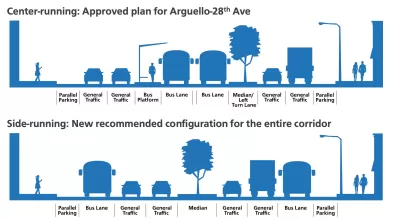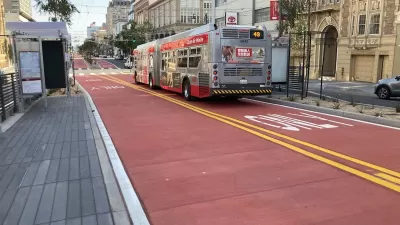Local business owners and the local elected official opposed the Geary transit-only lane project, but compromise and wide public support got the project across the finish line.

The San Francisco Municipal Transportation Agency Board of Directors recently approved a controversial bus-only lane on Geary Boulevard, after two decades of planning, despite the protests of local business owners. Transit planners in the city expect the project to save time for bus riders on a popular route through the city’s Richmond District as well as converting an estimated 7,000 car trips into transit rides. The project’s Environmental Impact Report was approved in 2017.
“Starting this fall, the San Francisco Municipal Transportation Agency will add transit-only lanes between 33rd Avenue and Stanyan Street, a heavily traveled corridor that also encompasses much of the city’s Richmond District,” reports Ida Mojadad. “In addition to turn restrictions and curb extensions for easier bus boarding, the project will change the angled parking between 28th and 15th avenues into parallel parking to make space for the bus lanes.”
“The agency estimates that these improvements will save over five minutes for 38-Geary riders on that segment each day, adding up to nearly 23 hours a year and easing operational constraints,” adds Mojadad.
The project overcame substantial controversy, including histrionic protests, to gain approval. The day before the approval, a group of Geary Boulevard businesses held a mock funeral to draw attention to their perceived plight. The opposition did accomplish substantial revisions to the plan, including a reduction in the number of parking spots removed for the lane, and a switch from a center-running configuration, similar to the bus rapid transit route along Van Ness Avenue, to a side-running configuration.
“Supporters of the project touted safety benefits for pedestrians. Geary Boulevard, with three lanes of traffic in each direction plus parking, is one of the city’s widest thoroughfares. On average, one pedestrian is injured by a traffic collision in the area each month, according to the SFMTA,” reports Mojadad.
More details on the project, and the public support for the project, are included in the source article below.
FULL STORY: San Francisco Officials Approve Geary Blvd. Transit-Only Lanes Despite Protests

Maui's Vacation Rental Debate Turns Ugly
Verbal attacks, misinformation campaigns and fistfights plague a high-stakes debate to convert thousands of vacation rentals into long-term housing.

Planetizen Federal Action Tracker
A weekly monitor of how Trump’s orders and actions are impacting planners and planning in America.

In Urban Planning, AI Prompting Could be the New Design Thinking
Creativity has long been key to great urban design. What if we see AI as our new creative partner?

King County Supportive Housing Program Offers Hope for Unhoused Residents
The county is taking a ‘Housing First’ approach that prioritizes getting people into housing, then offering wraparound supportive services.

Researchers Use AI to Get Clearer Picture of US Housing
Analysts are using artificial intelligence to supercharge their research by allowing them to comb through data faster. Though these AI tools can be error prone, they save time and housing researchers are optimistic about the future.

Making Shared Micromobility More Inclusive
Cities and shared mobility system operators can do more to include people with disabilities in planning and operations, per a new report.
Urban Design for Planners 1: Software Tools
This six-course series explores essential urban design concepts using open source software and equips planners with the tools they need to participate fully in the urban design process.
Planning for Universal Design
Learn the tools for implementing Universal Design in planning regulations.
planning NEXT
Appalachian Highlands Housing Partners
Mpact (founded as Rail~Volution)
City of Camden Redevelopment Agency
City of Astoria
City of Portland
City of Laramie





























